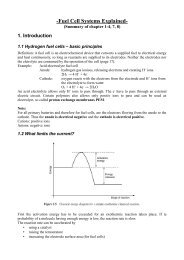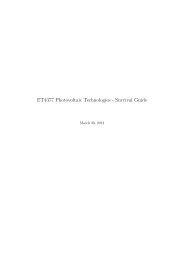minimum difference. This so-called pinch temperature defines the target <strong>for</strong> the optimumprocess design, since in a real system heat cannot transferred <strong>from</strong> above or below thistemperature.Other considerations taken into account are the materials of the BOP components <strong>and</strong> theirmechanical layout.7.4 The molten carbonate fuel cell MCFCThe electrolyte is a molten mixture of alkali metal carbonates, usually lithium <strong>and</strong> potassium orlithium <strong>and</strong> sodium, which is retained in a ceramic matrix of LiAlO 2 . At the operation temperatureof 600°-700°C the alkali carbonates <strong>for</strong>m a highly conductive molten salt, with CO 3 2- as mobile ion.Unlike other fuel cells, CO 2 <strong>and</strong> O 2 needs to be supplied at the cathode. Figure 7.9 shows theprincipal function of a MCFC with the electrode reactions.The Nernst reversible potential, taken the CO 2 transfer into account, is given byIn practice the CO 2 produced at the anode is externally recycled to the cathode. The anod exhaustgas is fed to a burner, which converts any unused fuel into water <strong>and</strong> CO 2 . The exit flow of theburner is then supplied with fresh air to the cathode inlet. The process also pre-heat the reactant air.Another method of reuse the CO 2 is a membrane seperator. The advantage of this method is unusedfuel gas can be recycled to the anode or used <strong>for</strong> other purposes. If an external supply of CO 2 isalready existing this can also be used.MCFC doesn't need nobel metal catalysts, due to the high operating temperature. Nickel (anode)<strong>and</strong> nickel oxide (cathode) is used.Furthermore it is also able to convert CO directly <strong>and</strong> re<strong>for</strong>m hydrocarbon fuels directly. The highoperating temperature of MCFCs provides the opportunity <strong>for</strong> achieving higher overall systemefficiencies <strong>and</strong> greater flexibility in use of available fuels compared to low temperature cells.Un<strong>for</strong>tunately, the higher temperatures <strong>and</strong> the aggresive medium of molten carbonate electrolytealso place severe dem<strong>and</strong>s on the corosion stability <strong>and</strong> life of the cell components.7.4.2 Implications of using a molten carbonate electrolyteMCFC uses a liquid electrolyte that is immobilised in a porous ceramic matrix. The electrolyteinterfacial boundaries are established by a balance in capillar pressures in the MCFC. By properlyco-ordinating the pore diameters in the electrodes <strong>and</strong> in the electrolyte matrix, the electrolytedistribution is established. The smaller pores in the matrix remain completely filled, while thebigger pores in the electrodes are partially filled. The electrolyte management is a critical point toachieve hich per<strong>for</strong>mance <strong>and</strong> endurance.
7.4.3 <strong>Cell</strong> components in a MCFCElectrolyteMCFC electrolytes contain typically 60wt% of carbonate constrained in a matrix of 40wt%LiOALO 2 . The ohmic resistance of the electrolyte <strong>and</strong> especially the ceramic matrix has animportant effect on the operating voltage. They account <strong>for</strong> around 70% of the ohmic losses, whichdepends mainly on the thickness t of the electrolyte according toΔV = 0.533 x tThe ceramic matrices can nowadays be made quite thin (0.25 – 0.5mm), by using tapecastingmethods, what counteracts the long-term stability, which is obtained with thicker materials.Note that, in contrast to the other types, the final preperation is carried out once the stackcomponents are assembled. The whole package is heated up slowly. At its melting temperature thecarbonate is absorbed by the matrix. That leads to a significant shrinkage of the stack. Damages dueto the shrinkage have to be provided. In addition, a reducing gas has to be supplied to the anode,while heating up, to ensure that the nickel anode remains in the reduced state.Heating <strong>and</strong> cooling of a MCFC needs time to avoid cracking the electrolyte matrix. It is alsonecessary to protect the anode at lower temperatures of oxidation with inert gas. There<strong>for</strong>e they arebest used in continous processes.AnodesAnodes are made of porous sintered NiCr/NiAl alloy, with a thickness of 0.4 to 0.8mm <strong>and</strong> aporosity of 55 – 75%. Cr is added in order to reduce the sintering of the Ni during cell operation. Itleads on the other side to bigger pores, so less surface area <strong>and</strong> finally to a per<strong>for</strong>mance drop, due toredistribution of carbonate <strong>from</strong> the electrolyte. Cr also reacts with the Li in the electrolyte ovr thetime. To overcome this, Al is added, to improve the creep resistance in the anode <strong>and</strong> reduceelectrolyte losses. The anodes have achieved a commercial acceptable stability but are veryexpensive.A high surface area of the anode is not required, because the anode reaction is fast in respect to thecathode reaction. Because of this the anode is partially flooded to provide a reservoir <strong>for</strong> carbonate.Nowadays, using the tape cast structure it is possible to control the pore distribution; Small poresclose to the electrolyte, larger pores near the fuel gas channels. However, long term electrolyte lossis still a significant problem with MCFC.CathodesThe major problem with the cathode is that the nickel oxide has a small, but significant, solubility inmolten carbonate, thus metallic nickel can precipitate out in the elctroclyte, that can cause internalshort circuits with a subsequent loss of power. The precipitated nickel can act as a sink <strong>for</strong> nickelions, which promates further dissolution. This problem can be reduced by using basic carbonates,operating at atmospheric pressure <strong>and</strong> low CO 2 partia; pressure.Non-porous componentsThe bipolare plates <strong>for</strong> a MCFC are usually made of stainless stell, which is coated at the anode sidewith nickel, due to the reducing environment at the anode, <strong>and</strong> with a thin layer of aluminium toavoid corrosion. The sealing is achieved by connecting the bipolare plate with the liquid electrolyteoutside the electrochemically active area.7.4.5 Internal re<strong>for</strong>mingThe principal variations of internal re<strong>for</strong>ming in a MCFC are direct internal re<strong>for</strong>ming DIR <strong>and</strong>indirect internal re<strong>for</strong>ming IIR. DIR offers a higher cell per<strong>for</strong>mance. The product of the re<strong>for</strong>mingreaction, hydrogen, is directly consumed by the electrochemical reaction, there<strong>for</strong>e the re<strong>for</strong>mingreaction is shifted in the <strong>for</strong>ward direction. This leads to a higher conversion of hydrocarbon thanwould normally expected. A thigh fuel utilisation in a DIR MCFC nearly 100% of methane is






